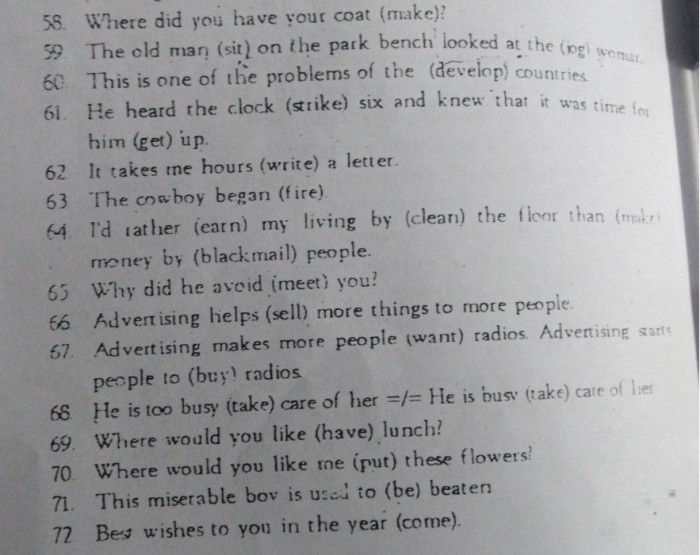1. Đáp án: made
Giải thích: Câu hỏi yêu cầu sử dụng dạng quá khứ của động từ "make" để hỏi về việc ai đó đã làm chiếc áo khoác.
2. Đáp án: sitting, joyful
Giải thích: "The old man sitting on the park bench" là cụm từ mô tả người đàn ông, và "joyful" là tính từ đúng để mô tả người phụ nữ.
3. Đáp án: developing
Giải thích: "Developing countries" là cụm từ thường dùng để chỉ các quốc gia đang trong quá trình phát triển.
4. Đáp án: strike, to get
Giải thích: "He heard the clock strike six" là cách diễn đạt đúng, và "to get up" là động từ nguyên thể chỉ hành động.
5. Đáp án: to write
Giải thích: "It takes me hours to write a letter" là cấu trúc đúng với động từ nguyên thể.
6. Đáp án: to earn, blackmailing
Giải thích: "I'd rather earn my living by blackmailing people" là cách diễn đạt đúng với động từ nguyên thể và gerund.
7. Đáp án: meeting
Giải thích: "Why did he avoid meeting you?" là cách diễn đạt đúng với gerund.
8. Đáp án: đúng
Giải thích: Câu này đúng ngữ pháp và có nghĩa là quảng cáo giúp bán nhiều sản phẩm hơn cho nhiều người hơn.
9. Đáp án: buy
Giải thích: "People buy radios" là câu khẳng định đơn giản, đúng ngữ pháp.
10. Đáp án: to take
Giải thích: "He is too busy to take care of her" là cấu trúc đúng với động từ nguyên thể.
11. Đáp án: to have
Giải thích: "Where would you like to have lunch?" là câu hỏi đúng với động từ nguyên thể.
12. Đáp án: being
Giải thích: "This miserable boy is used to being beaten" là cách diễn đạt đúng với gerund.
13. Đáp án: coming
Giải thích: "in the year coming" là cách diễn đạt đúng để chỉ năm sắp tới.
Trang chủ
Giải bài tập Online
Đấu trường tri thức
Dịch thuật
Flashcard - Học & Chơi
Cộng đồng
Trắc nghiệm tri thức
Khảo sát ý kiến
Hỏi đáp tổng hợp
Đố vui
Đuổi hình bắt chữ
Quà tặng và trang trí
Truyện
Thơ văn danh ngôn
Xem lịch
Ca dao tục ngữ
Xem ảnh
Bản tin hướng nghiệp
Chia sẻ hàng ngày
Bảng xếp hạng
Bảng Huy hiệu
LIVE trực tuyến
Đề thi, kiểm tra, tài liệu học tập








 Trả lời nhanh trong
Trả lời nhanh trong 



 Xem thêm
Xem thêm  Thưởng th.11.2024
Thưởng th.11.2024 Bảng xếp hạng
Bảng xếp hạng